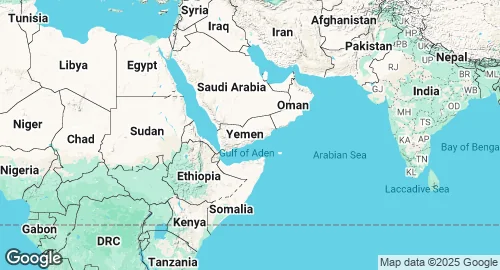Yemen Military Forces 🇾🇪
Military Strength Overview
| 🛩️ Air Force | 168 active aircraft |
| ⚓️ Naval forces | 31 ships in fleet |
| 🪖 Active Troops | 40,000 personnels |
Defense Statistics & Key Metrics
| Population | 34.1 million (2018) |
| GDP | $21.6 billion (2018) |
| GDP per capita | $634 (2018) |
| Military Budget | $1.7 billion (2014) |
| Share of GDP in Milex | 4.0% (2014) |
| Share of Govt Expenditures | 14.3% (2014) |
| Military spends per capita | $58 (2014) |
| Inflation Rate | 8.1% (2014) |
| Military Personnel | 20,000 (2018) |
Strategic Overview in 2025
Yemen's military strength is not a unified concept but rather a fractured landscape of competing factions, each with varying degrees of military capability and external support. The ongoing civil war, which began in earnest in 2014, has effectively splintered the official Yemeni Armed Forces. The internationally recognized government, now led by the Presidential Leadership Council, nominally controls a collection of military units, but its true power on the ground is limited and heavily dependent on a Saudi-led coalition. This coalition, which includes the United Arab Emirates, has provided air support, ground troops, and materiel, but has failed to dislodge the rival Houthi movement.
The Rise of Houthi Military Power
The most significant military force in Yemen today is the Houthi movement, which controls the capital, Sana'a, and most of northern Yemen. From a localized armed group, the Houthis have transformed into a potent military organization. This evolution is largely due to substantial military, financial, and logistical support from Iran and its allies, including Hezbollah. This assistance has provided the Houthis with increasingly sophisticated weaponry, including ballistic and cruise missiles, and unmanned aerial vehicles (drones), which they have used to strike targets deep within Saudi Arabia and the UAE, and to disrupt international shipping. Recent UN reports indicate that the scale of this foreign support is "unprecedented" and has been decisive in bolstering the Houthis' military prowess.
Strategic Location and Trends
Yemen's strategic importance is primarily defined by its control over the Bab el-Mandeb strait, a narrow chokepoint connecting the Red Sea to the Gulf of Aden and a critical artery for global maritime trade. The Houthi attacks on commercial shipping, framed as a response to regional conflicts, have demonstrated their ability to impact the global economy and have drawn in international military responses, including from the United States and the United Kingdom.
The strategic trends for Yemen are bleak. The civil war has devolved into a complex proxy conflict between Iran and Saudi Arabia, making a political settlement elusive. The country is deeply fragmented, with various factions vying for control, including southern secessionist movements. The conflict has created one of the world's worst humanitarian crises, with widespread famine and displacement. The continued proliferation of advanced weaponry and the increasing sophistication of the Houthi arsenal pose a persistent threat to regional stability and international maritime security.
Yemeni Military Budget History
Population and Military Personnel Trends
GDP and Inflation Rate Trends
Military Expenditure: SIPRI Milex.
